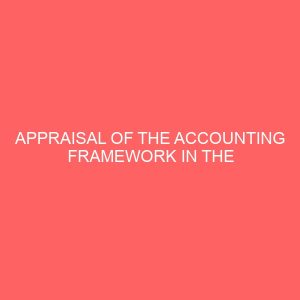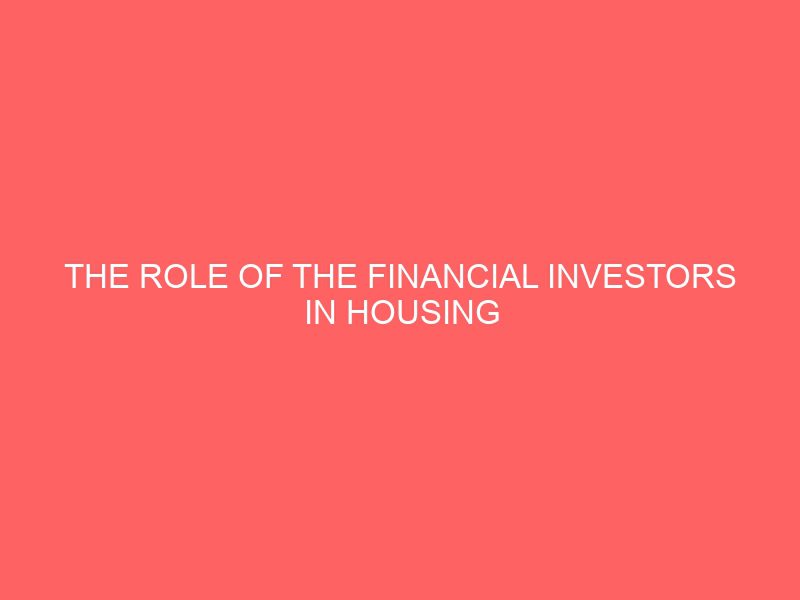Description
CHAPTER ONE
BACKGROUND TO THE STUDY
1.1 Introduction
This study is on the role of the financial investors in housing provisioning in Nigeria. Housing as a social need is vital to socio-economic development of every country (Giddings, 2007). The housing Investors is generally accepted as one of the most important determinants of the economic and social wellbeing of people. It plays a key role in the lives of people as the provision of shelter is one of the basic necessities of man (Moss, 2010). The need to provide adequate housing cannot be over emphasized and its importance can hardly be exaggerated (IMF, 2011).
Derban et al (2002) indicate that the availability of adequate and decent housing enhances good living conditions and productivity of all individuals. It plays a vital role in the health, happiness and civilized living of the individuals. Housing does not only satisfy the physical and biological requirement of man but also upholds his dignity and improves his quality of life (NCH, 2008). The provision of housing is so linked with national economic development that the rate of house construction is directly related to the economic performance of a country (BoG, 2007).
Unfortunately, the provision of housing worldwide has not been able to meet demand (Ogu and Ogbuozobe, 2001). This lag can be attributed to the population surge which has more than doubled in numbers in recent times (Giddings, 2007). Most developing countries are confronted with the problem of accommodating the rapidly growing population especially in their urban areas and Ghana is not an exception (Konadu- Agyeman, 2001). The provision of adequate shelter is one problem that the country has had to contend with. The inadequate housing stock and the lack of basic housing requirements induces stress and affects the living condition of households as well as productivity( Derban et al,2002).
One of the major problems facing housing delivery in Ghana is finance. The unavailability and inaccessibility of housing finance mechanisms has been identified as one of the important hurdles in improving housing delivery in the country (Hoek- Smit, 1998).
There are two main sources of finance in the housing finance system (Moss, 2010). They are the formal and financial sources. The formal source consists of government budgetary allocation and financial institutions in the form of mortgages. The financial sources include personal/family savings, individual money lenders, and remittances from family members.
Over the years, government of Ghana through housing schemes and plans has found ways and means of financing housing in the country. The rationale for government intervention in the housing market revolves around the goal of providing all Ghanaians with a decent house in a suitable living environment (IFA, 1993). During the 1970‟s and the 1980‟s, the main focus of government housing intervention in the country was by embarking on mass housing projects for the citizenry with the government being the sole financier of the projects. Examples of some of these housing projects are the government built low and medium class estates for civil servants (Afrane and Asamoah, 2011).
Currently government plays a double role when it comes to financing housing delivery (IFA, 1993). The government plays a direct role through the construction of public/mass houses but it is mostly not realized due to the lack of funds, lack of coordination and policy abandonment due to change in government. The government also plays an indirect role by creating an enabling environment through tax policies which includes tax subsidies for real estate developers and subsidized interest rates for borrowers from financial institutions associated to housing finance (eg. Home Finance Company Ltd).
The liberalization of the housing market has facilitated the involvement of the private Investors in housing delivery (Sangore, 2003).The private Investors currently produces over 83 percent of the total housing stock in the country(Boamah, 2010).The private Investors is divided into formal and financial investors. The formal Investors includes the real estate developers and cooperative societies. These developers construct housing projects for individuals to purchase them but this approach mostly exempts the poor and the middle income earners due to the high cost of the houses. The formal Investors actors provide only a few thousand dwellings in a year (UN-Habitat, 2011).The financial Investors consists of individuals who engage in housing provision for themselves. Given the apparent trends in most of the developing countries, there are indications that the bulk of urban housing in these countries will continue to be produced by the financial Investors (Okpala, 1994; Ikejiofor, 1997). There is the need for efficient and effective housing finance systems for the financial Investors since finance plays a key role in housing delivery.
1.2 Problem Statement
The Ministry of Water Resources, Works and Housing asserts that in order for the nation to remove the housing deficit of 1.7 million, the national housing production should be 170,000 units annually (MWWH, 2013). However the current supply capacity of the nation is in the region of 42,000 units per year (Afrane and Asamoah, 2011). Demand for housing in Ghana is higher in the three major urban areas; which are Accra, Nigeria and Sekondi-Takoradi (UN-Habitat, 2011). The Nigeria Metropolitan Assembly estimated that the total housing stock in Nigeria as of 2009 was 83, 693 (KMA, 2010) and this was distributed fairly amongst the ten sub metropolitan councils. The housing deficit in Nigeria Metropolis is startling since the total number of houses as of 2010 compared with the number of households indicated acute overcrowding in most houses (KMA, 2011). This constitutes a major problem and calls for an urgent need to address the situation.
Even though the financial Investors is by far the largest housing supply system in most urban areas, it has not been able to meet the increasing demand for housing partly as a result of the inadequate and ineffective financial mechanisms for financing housing in the country (Moss, 2010). Finance is crucial to housing by the financial Investors and lack of access to financial resources is a major problem facing this Investors (Ogu and Ogbuozobe, 2001).
In Ghana, very little is known about how homeowners finance the construction of new housing but it is however known that few homeowners have access to formal finance. This is because upfront finance is not easily accessible to allow them to purchase a higher quality home and pay for it over a longer and suitable period (Wapwera,et al,2014). This has resulted in most people financing through their personal savings but mobilizing savings and channeling them to finance housing projects has proven very difficult due to the type and nature of the jobs of the people in the financial Investors. They mostly do not have job security to enable them to save consistently. Personal savings also have had to compete with other household expenses making it extremely difficult (Ferguson and Smets, 2009).
Moreover, financial institutions are cautious about lending to the individuals thereby making access to credit facilities very difficult (Hoek-Smit, 1998). They provide very little support to low and moderate households in the form of mortgages. Some only provide mortgage loans for a small proportion of newly constructed houses and home purchases (Hoek-Smit, 1998).But even these financial institutions have made very little progress in this regard. Financial institutions mostly do not want to consider long-term lending for housing a priority because of the associated risks involved in the jobs of the financial Investors. These risks include insecure and undocumented incomes and the lack of collateral on the part of the private individuals (Hoek-Smit, 1998).The limited access to finance has partly led to the development of slums and squatter settlement and poor housing conditions.
The study focused on housing finance by the financial Investors. The financing options available to them and how they accessed funds for their housing projects and what can be done to improve their efforts in housing delivery in Nigeria Metropolis.
1.3 Research Questions
- What are the housing finance arrangements used by the financial Investors in Nigeria?
- What are the housing finance mechanisms that provide access to housing credit facilities to the financial Investors?
- What factors hinder access to housing credit to the financial Investors?
- What financial system can be put in place to improve access to housing finance by the financial Investors?
1.4 Research Objectives
The main objective is to have a comprehensive understanding of the housing finance practises by the financial Investors in Nigeria. The specific objectives are:
- To know the different types and characteristics of housing finance mechanisms available to the financial Investors in Nigeria.
- To determine the major housing finance mechanism used by the financial Investors and how it affects housing delivery.
- To identify the factors that hinder the financial Investors from access to formal housing credit facilities.
- To make suggestions for the improvement of access to formal housing finance by the financial Investors.
1.5 Scope
Geographically the study is focused on Nigeria, the second largest city in Ghana after the national capital, Accra in terms of population, social life and economic activities. Nigeria is the capital of the Ashanti region. It covers an area of approximately 254 sq. km. (GSS, 2005) with a population of 2,035,064 (GSS, 2012). The Nigeria Metropolis is made of ten sub metropolitan areas with each having its own unique housing characteristics. Nigeria as at 2009 has an estimated housing stock of 83,693(KMA, 2010) growing at 2.4 percent per annum.
Contextually, the study was on housing finance by the financial Investors in Nigeria. It looked at the housing finance mechanisms used by the financial Investors and the factors that hindered their access to formal credit facilities. The focus was on residential housing units with emphasis on private individual ownership.
1.6 Methodology
The study adopted a cross-sectional design as a research approach and relied on both secondary and primary data sources. The simple random technique was used to select the ten communities from the ten sub metropolitan areas whilst the purposive and convenience sampling techniques were used in selecting the institutions and homeowners respectively.
The units of analysis were residential home owners, officials of the Ministry of Water Resources, Works and Housing, SSNIT, some financial institutions (HFC Bank Ltd, Ecobank, UBA) and the planning and statistical department of Nigeria Metropolitan Assembly. (For more on the methodology, see chapter three of the report).
1.7 Significance of the Study
The demand for housing in the country is very worrying and alarming. The Ministry of Water Resources, Works and Housing estimates that the country needs about 170,000 housing units annually but is able to produce just 35 percent of that total number. Meanwhile GREDA also asserts the nation is able to produce only 42,000 units per year from the required annual 130,000 units (Afrane and Asamoah, 2011). These two assertions show that the country has an annual housing deficit that needs to be tackled.
Housing finance is a major problem in housing delivery in the country. Although the financial Investors plays a very key role in housing delivery, it has very limited access to credit facilities due to the nature of their jobs. This has led to sub standard construction of housing units, overcrowding in housing units, poor housing conditions and the emergence of slums and squatter settlements.
The study therefore gives more insight into how the financial Investors finance housing in Nigeria and the housing finance mechanisms available for them and also make suggestions to the most appropriate housing finance mechanisms for the financial Investors to improve housing delivery. The study helps to know how best the financial Investors can access housing finance mechanisms fully in order to improve the housing situation in the Nigeria Metropolis.
1.8 organization of the Study
The report is organized into six chapters. Chapter One of the report covered the general introduction to the study. It gave insight into the objectives, scope and significance and methodology of the study.
Chapter Two discussed the literature on the practical aspect and the various concepts of the study. This literature gave more insight into the housing finance systems pertaining in both the developed and developing countries.
Chapter Three discussed the methodology of this study. The chapter provided theoretical understanding of data collection techniques that were used and further explained how these techniques were applied.
Chapter Four looked at the profile of the study area. It provided a detailed background of the study area which included the history, physical and demographic characteristics and the housing situation in the Nigeria Metropolis.
Chapter Five focused on the analysis and presentation of the data collected from the various stakeholders involved in the study. The data collected were presented in tables, charts and diagrams.
Chapter Six was the final chapter and presented the summary of findings, the conclusion and recommendations to address financial Investors housing finance challenges in the Nigeria Metropolis.
1.9 Chapter Overview
The chapter gave a general introduction to the study. It looked at the objectives of the study, the research questions and the significance of the study. It also gave a brief introduction to the methodology that was used in the study. This allowed relevant literature on the study to be discussed in the next chapter.







